 Slapstick #1 — Writers: Reilly Brown and Fred van Lente; Storyboards: Reilly Brown; Art: Diego Olortegui; Colors: Jim Campbell
Slapstick #1 — Writers: Reilly Brown and Fred van Lente; Storyboards: Reilly Brown; Art: Diego Olortegui; Colors: Jim Campbell
Star Wars: Doctor Aphra #1 — Writer: Kieron Gillen; Art: Kev Walker; Colors: Antonio Fabela; (Second Story): Writer: Kieron Gillen; Art: Salvador Larroca; Colors: Edgar Delgado
Nova #1 — Writers: Jeff Loveness and Ramon Perez; Art: Ramon Perez; Colors: Ian Herring
Of the Marvel first issues this week, Slapstick is the most unusual, with its living-cartoon character existing in the “real” Marvel world; the cover gives the main idea, that he uses Bugs Bunny-like violence that doesn’t affect him — you could drop an anvil on his head, and he’d flatten out, pop back up and shake it off — but that can maim and even kill his opponents. Since he’s a mercenary, and this is all played for laughs, it’s striving 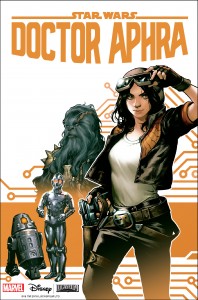 for a Deadpool tone (logical, considering he’s been a character in the Mercs for Money book), and, as with that book at its best, it’s the contrast between the brightly-colored, animated character and the darker implications of his actions that might make this interesting. Good start, and worth a look, with more than enough cool visuals and ideas to bring readers back for another issue. Doctor Aphra sees writer Kieron Gillen continuing his breakout character from the Darth Vader series, a roguish space archeologist who’s a combination of Indiana Jones and Hans Solo, except that she’s a sociopathic killer too, and on the Empire’s side (at least, when it coincides with her own money-making schemes). Mix in her companions, a pair of casually-homicidal robots and a warrior Wookie who act like dark-mirrored reflections of R2D2, C3PO and Chewbacca, and there’s a lot to like here; Marvel’s debuting this as an ongoing book, instead of a mini-series, which shows that they have some confidence in the concept, too, and as a brand-new Star Wars book this
for a Deadpool tone (logical, considering he’s been a character in the Mercs for Money book), and, as with that book at its best, it’s the contrast between the brightly-colored, animated character and the darker implications of his actions that might make this interesting. Good start, and worth a look, with more than enough cool visuals and ideas to bring readers back for another issue. Doctor Aphra sees writer Kieron Gillen continuing his breakout character from the Darth Vader series, a roguish space archeologist who’s a combination of Indiana Jones and Hans Solo, except that she’s a sociopathic killer too, and on the Empire’s side (at least, when it coincides with her own money-making schemes). Mix in her companions, a pair of casually-homicidal robots and a warrior Wookie who act like dark-mirrored reflections of R2D2, C3PO and Chewbacca, and there’s a lot to like here; Marvel’s debuting this as an ongoing book, instead of a mini-series, which shows that they have some confidence in the concept, too, and as a brand-new Star Wars book this  should do well, and have a good chance for a long life. Nova is the least-new first issue, since it’s basically just a continuation of the current comic, but it’s got a different creative team (Loveness, a writer on Jimmy Kimmel Live, scripted the surprisingly-affecting Groot mini-series earlier this year, and Perez showed versatility and skill with his artwork on All-New Hawkeye with Jeff Lemire), and a new supporting-cast member: Richard Rider, the original version of the title character. That should be enough of a mix to encourage both old and new readers to check out the book, and might even allow Marvel a rare hat-trick: three successful new series in one week.
should do well, and have a good chance for a long life. Nova is the least-new first issue, since it’s basically just a continuation of the current comic, but it’s got a different creative team (Loveness, a writer on Jimmy Kimmel Live, scripted the surprisingly-affecting Groot mini-series earlier this year, and Perez showed versatility and skill with his artwork on All-New Hawkeye with Jeff Lemire), and a new supporting-cast member: Richard Rider, the original version of the title character. That should be enough of a mix to encourage both old and new readers to check out the book, and might even allow Marvel a rare hat-trick: three successful new series in one week.
 The Clone Conspiracy #3 (of 5) — Writer: Dan Slott; Pencils: Jim Cheung; Inks: John Dell; Colors: Justin Ponsor
The Clone Conspiracy #3 (of 5) — Writer: Dan Slott; Pencils: Jim Cheung; Inks: John Dell; Colors: Justin Ponsor
The Unworthy Thor #2 (of 4) — Writer: Jason Aaron; Art: Olivier Coipel; Colors: Matthew Wilson
The Avengers #2 — Writer: Mark Waid; Art: Mike del Mundo; Colors: Mike del Mundo with Marco D’Alphonso
Champions #3 — Writer: Mark Waid; Pencils: Humberto Ramos; Inks: Victor Olazaba; Colors: Edgar Delgado
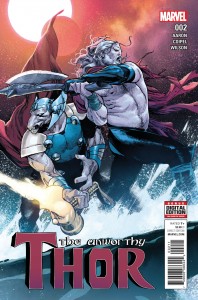 Moon Knight #9 — Writer: Jeff Lemire; Art: Greg Smallwood, Wilfredo Torres, Francesco Francavilla and James Stokoe; Colors: Jordie Bellaire, Michael Garland, Francesco Francavilla and James Stokoe
Moon Knight #9 — Writer: Jeff Lemire; Art: Greg Smallwood, Wilfredo Torres, Francesco Francavilla and James Stokoe; Colors: Jordie Bellaire, Michael Garland, Francesco Francavilla and James Stokoe
Of the ongoing Marvel books, Clone Conspiracy, the Spider-Man crossover book involving the villain the Jackal bringing a bunch of people back from the dead, is the issue that Slott said would “break the Internet.” Um, no — it does involve the return of one character, and the possible return of another: one was heavily involved in the original ’90s “clone” stories, and the other is the most iconic dead person in the Spider-Man mythos, so neither is surprising enough to do any www. damage. Otherwise, it’s the regular skillfully-constructed superhero soap opera, with Cheung doing a good job drawing the dozens of  characters, both good and bad, involved; his style would normally be a little shadowy for a Spidey book, but given the darker goings-on here, and the focus on death and revival, it fits well. Olivier Coipel uses a similarly-noir style on Unworthy Thor, and it works well there, too — Aaron’s Asgardian Odinson is in dire straits, captured by a powerful foe who wants something he can’t provide (the secret of how to lift an alternate-universe version of Mjolnir), so a darker palette is appropriate to the grim events unfolding. Since Aaron has been writing about the Asgardian characters and settings for a number of years now — including the current Mighty Thor comic — this all feel solidly in continuity, and important to the bigger story, so fans of that book, and of the cosmic-gods corner of the Marvel universe in general, should get this. Avengers continues its initial
characters, both good and bad, involved; his style would normally be a little shadowy for a Spidey book, but given the darker goings-on here, and the focus on death and revival, it fits well. Olivier Coipel uses a similarly-noir style on Unworthy Thor, and it works well there, too — Aaron’s Asgardian Odinson is in dire straits, captured by a powerful foe who wants something he can’t provide (the secret of how to lift an alternate-universe version of Mjolnir), so a darker palette is appropriate to the grim events unfolding. Since Aaron has been writing about the Asgardian characters and settings for a number of years now — including the current Mighty Thor comic — this all feel solidly in continuity, and important to the bigger story, so fans of that book, and of the cosmic-gods corner of the Marvel universe in general, should get this. Avengers continues its initial 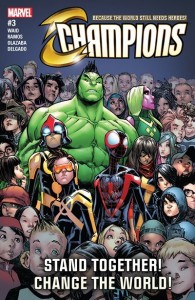 relaunch arc about Kang the Conqueror — in a number of his incarnations — attacking the team (Spider-Man, the Vision, Hercules, and the new versions of Thor, Captain America and the Wasp) through their pasts, by killing them in their cribs; writer Waid is an expert at the twisty plot threads and intimate knowledge of continuity required to make this work, while del Mundo’s plastic, painterly style (enhanced by his own coloring) gives all the figures a sheen that makes even the standard battle scenes refreshingly new. Waid’s also the writer on Champions, wherein the younger Marvel heroes — Ms. Marvel and Viv, the daughter of the Vision, plus the teen versions of Nova, the Hulk and Cyclops — use a combination of idealism and social-media skills to travel the world helping the oppressed. In some hands, that would be boring and preachy, but here, as they encounter a group of no-nonsense, courageous women in a
relaunch arc about Kang the Conqueror — in a number of his incarnations — attacking the team (Spider-Man, the Vision, Hercules, and the new versions of Thor, Captain America and the Wasp) through their pasts, by killing them in their cribs; writer Waid is an expert at the twisty plot threads and intimate knowledge of continuity required to make this work, while del Mundo’s plastic, painterly style (enhanced by his own coloring) gives all the figures a sheen that makes even the standard battle scenes refreshingly new. Waid’s also the writer on Champions, wherein the younger Marvel heroes — Ms. Marvel and Viv, the daughter of the Vision, plus the teen versions of Nova, the Hulk and Cyclops — use a combination of idealism and social-media skills to travel the world helping the oppressed. In some hands, that would be boring and preachy, but here, as they encounter a group of no-nonsense, courageous women in a 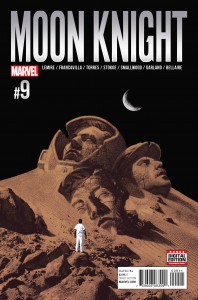 Middle-Eastern town besieged by ISIS fundamentalists, it’s smart, relatively subtle, uplifting… and, most importantly, entertaining, especially with Ramos’s art, and its ability to convey both drama and humor equally well. Moon Knight offers another smart writer — Jeff Lemire — and this week’s issue is the culmination of the previous eight, as we find out more about what’s going on with Marc Spector and his various alter egos, setting up a great big confrontation to finish the first arc with a flourish over the next few months. If you read the first couple chapters of this new incarnation, liked the art, but then dropped it, this is a great jump-back-on issue, especially with all those cool artists — Francavilla and Stokoe! — contributing to each aspect of Spector’s divided psyche.
Middle-Eastern town besieged by ISIS fundamentalists, it’s smart, relatively subtle, uplifting… and, most importantly, entertaining, especially with Ramos’s art, and its ability to convey both drama and humor equally well. Moon Knight offers another smart writer — Jeff Lemire — and this week’s issue is the culmination of the previous eight, as we find out more about what’s going on with Marc Spector and his various alter egos, setting up a great big confrontation to finish the first arc with a flourish over the next few months. If you read the first couple chapters of this new incarnation, liked the art, but then dropped it, this is a great jump-back-on issue, especially with all those cool artists — Francavilla and Stokoe! — contributing to each aspect of Spector’s divided psyche.
 Wonder Woman ’77 Meets the Bionic Woman #1 — Writer: Andy Mangels; Art: Judit Tondora; Colors: Michael Bartolo and Stuart Chaifetz
Wonder Woman ’77 Meets the Bionic Woman #1 — Writer: Andy Mangels; Art: Judit Tondora; Colors: Michael Bartolo and Stuart Chaifetz
Shade the Changing Girl #3 — Writer: Cecil Castellucci; Art: Marley Zarcone; Colors: Kelly Fitzpatrick
Deadman: Dark Mansion of Forbidden Love #2 (of 3) — Writer: Sarah Vaughn; Art: Lan Medina; Colors: Jose Villarruba
Harley Quinn #9 — Writers: Jimmy Palmiotti and Amanda Connor5; Art: Brandon Peterson with Michael Kaluta; Colors: Alex Sinclair
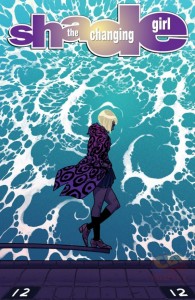 Batman #12 — Writer: Tom King; Pencils: Mikel Janin; Inks: Mikel Janin and Hugo Petrus; Colors: June Chung
Batman #12 — Writer: Tom King; Pencils: Mikel Janin; Inks: Mikel Janin and Hugo Petrus; Colors: June Chung
Some books tell you everything you need to now about them with their title; Wonder Woman ’77 Meets the Bionic Woman is one of those books. The art’s design-oriented but basic in the actual drawing — there are minimal backgrounds; clothes are often splashes of color with no wrinkles or folds; faces are recognizable but similarly minimalist — so it looks more like a Dynamite than a DC book. The story’s solid (Mangels is an expert on the Amazon Princess, and has contributed to numerous non-fiction works about her) but unsurprising, but it probably doesn’t matter: you either heard that  title and said “I’ve got to get that comic!” or you didn’t. Shade the Changing Girl continues its original conceit: a bird-like alien from Rac Shade’s original planet, Meta, steals his madness vest from a museum there and flees to Earth, where her consciousness inhabits the body of a comatose teen girl; she then has to navigate the alien horrors of high school, while back on Meta forces gather to track her down and retrieve the almost-certainly-dangerous vest before it can destroy her mind, the high school and Earth — unless she can keep it together and master her emotions. This third issue is a middle episode, so it isn’t the best place to start, but all three issues are still on the stands, and the comic’s edgy art and themes, mixed with some surreal madness attacks, make it a
title and said “I’ve got to get that comic!” or you didn’t. Shade the Changing Girl continues its original conceit: a bird-like alien from Rac Shade’s original planet, Meta, steals his madness vest from a museum there and flees to Earth, where her consciousness inhabits the body of a comatose teen girl; she then has to navigate the alien horrors of high school, while back on Meta forces gather to track her down and retrieve the almost-certainly-dangerous vest before it can destroy her mind, the high school and Earth — unless she can keep it together and master her emotions. This third issue is a middle episode, so it isn’t the best place to start, but all three issues are still on the stands, and the comic’s edgy art and themes, mixed with some surreal madness attacks, make it a 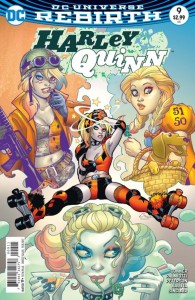 worthy successor to its ’90s Vertigo predecessor. Deadman continues its mix of Gothic-haunted-mansion horror and relationship soap opera (with a little super-heroing mixed in); its square-bound, 48-page format (with no ads) is a throwback to DC’s ’90s output too, and gives readers a satisfying chunk of Lan Medina’s pretty, atmospheric art for their $5.99. Harley Quinn is a typical outing for that character, with writers Palmiotti and Connor continuing to make her, somehow, empowering and fun instead of exploitive and cringe-inducing; this issue’s worth noting because there’s a four-page dream sequence (courtesy of a bump to Harley’s head) of her and Poison Ivy, drawn by comics legend Michael Kaluta. Batman’s in the middle of an “I
worthy successor to its ’90s Vertigo predecessor. Deadman continues its mix of Gothic-haunted-mansion horror and relationship soap opera (with a little super-heroing mixed in); its square-bound, 48-page format (with no ads) is a throwback to DC’s ’90s output too, and gives readers a satisfying chunk of Lan Medina’s pretty, atmospheric art for their $5.99. Harley Quinn is a typical outing for that character, with writers Palmiotti and Connor continuing to make her, somehow, empowering and fun instead of exploitive and cringe-inducing; this issue’s worth noting because there’s a four-page dream sequence (courtesy of a bump to Harley’s head) of her and Poison Ivy, drawn by comics legend Michael Kaluta. Batman’s in the middle of an “I  Am Suicide” arc involving the Caped Crusader invading Bane’s island with a hand-picked Suicide Squad; seemingly, Catwoman has betrayed the group, and the whole issue is Batman fighting his way through the island to Bane’s fortress to confront him and her — except at the beginning and end, there’s no dialogue, with the captions instead recounting a long letter Bruce Wayne wrote to Selina Kyle the last time she got stuck in Arkham Asylum. King is very good at this sort of thing (his Batman writing continues to meet the bar set by Scott Snyder), and Mikel Janin nails the whole silent-battle bit, to create a just-unusual-enough-to-be-cool comic book.
Am Suicide” arc involving the Caped Crusader invading Bane’s island with a hand-picked Suicide Squad; seemingly, Catwoman has betrayed the group, and the whole issue is Batman fighting his way through the island to Bane’s fortress to confront him and her — except at the beginning and end, there’s no dialogue, with the captions instead recounting a long letter Bruce Wayne wrote to Selina Kyle the last time she got stuck in Arkham Asylum. King is very good at this sort of thing (his Batman writing continues to meet the bar set by Scott Snyder), and Mikel Janin nails the whole silent-battle bit, to create a just-unusual-enough-to-be-cool comic book.
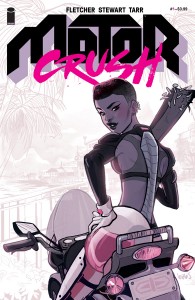 Motor Crush #1 — Writers: Brandon Fletcher and Cameron Stewart; Art/Colors: Babs Tarr
Motor Crush #1 — Writers: Brandon Fletcher and Cameron Stewart; Art/Colors: Babs Tarr
Uber: Invasion #1 — Writer: Kieron Gillen; Art: Daniel Gete; Colors: Digikore Studios
Reggie and Me #1 — Writer: Tom Defalco; Art: Sandy Jarrell; Colors: Kelly Fitzpatrick
Of the indy debuts, Motor Crush is the most-anticipated; it’s from the creative team of last year’s Batgirl, which revitalized the character and was both a critical favorite and a hit (in trade form, 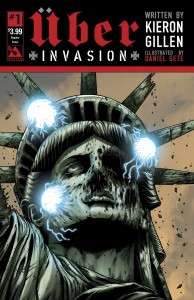 anyway), especially with the younger female readers that DC’s been trying desperately to attract. The heroine is a World Grand Prix motorcycle racer who also does illegal street-racing on the side, which gives Babs Tarr’s kinetic layout and figure work a chance to shine; she’s reminiscent of Darwyn Cooke in her confident, cartoony style and precise line. Uber: Invasion is a relaunch of Kieron Gillen’s alternate-history tale of a world where the Nazis discovered how to create supermen right at the tail end of WWII, and used them to turn the tide of the war; in this new arc, they’re carrying the battle to the American mainland, as the US
anyway), especially with the younger female readers that DC’s been trying desperately to attract. The heroine is a World Grand Prix motorcycle racer who also does illegal street-racing on the side, which gives Babs Tarr’s kinetic layout and figure work a chance to shine; she’s reminiscent of Darwyn Cooke in her confident, cartoony style and precise line. Uber: Invasion is a relaunch of Kieron Gillen’s alternate-history tale of a world where the Nazis discovered how to create supermen right at the tail end of WWII, and used them to turn the tide of the war; in this new arc, they’re carrying the battle to the American mainland, as the US  desperately tries to bring its own powered fighters up to the German level; the book’s cover indicates their lack of success. Reggie and Me is another of those books whose content is clear by its title: it’s focused on Archie Andrews’s nemesis and resident Riverdale High School prankster. A book about the bad guy isn’t easy (Marvel’s never been able to sustain a Doctor Doom comic, nor DC a Lex Luthor one), but writer Defalco does a good job of making it work (the narrator is Reggie’s dog, the one creature who loves and gets him), and if you’ve been liking the other offerings in the new “modern” Archie line, you should like this one too.
desperately tries to bring its own powered fighters up to the German level; the book’s cover indicates their lack of success. Reggie and Me is another of those books whose content is clear by its title: it’s focused on Archie Andrews’s nemesis and resident Riverdale High School prankster. A book about the bad guy isn’t easy (Marvel’s never been able to sustain a Doctor Doom comic, nor DC a Lex Luthor one), but writer Defalco does a good job of making it work (the narrator is Reggie’s dog, the one creature who loves and gets him), and if you’ve been liking the other offerings in the new “modern” Archie line, you should like this one too.
 Josie and the Pussycats #3 — Writers: Marguerite Bennett and Cameron Deordio; Art: Audrey Mok; Colors: Kelly Fitzpatrick
Josie and the Pussycats #3 — Writers: Marguerite Bennett and Cameron Deordio; Art: Audrey Mok; Colors: Kelly Fitzpatrick
Violent Love #2 — Writer: Frank J. Barbiere; Art/Colors: Victor Santos
Spook House #2 — Writer/Artist: Eric Powell; Other Artists: Steve Mannion and Stephanie Gladden; Colors: Thomas Gaadt, K. Michael Russell and Eric Powell
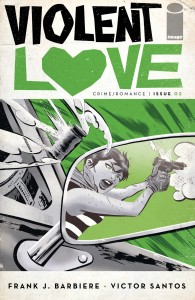 The Wicked and the Divine #24 — Writer: Kieron Gillen; Art: Jamie McKelvie; Colors: Matthew Wilson
The Wicked and the Divine #24 — Writer: Kieron Gillen; Art: Jamie McKelvie; Colors: Matthew Wilson
Island #13 — Creators: Various
Speaking of the rest of the Archie line… Josie and the Pussycats doesn’t have the cutting-edge, fashion-conscious zip of that other girl-group comic, Jem and the Holograms — its art, which is more than appealing enough, leans toward the cartoony-manga — but writer Bennett gives it some pop-culture snap (she name-checks both Archer and 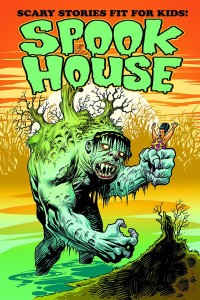 Bojack Horseman), and some emotional heft, this issue in examining the Josie/Alexandra rivals/former bffs relationship, and making some surprising points about it. Violent Love is hard-boiled sexy-crime noir, with an art style a lot like Darwyn Cook’s Parker books (the second Cooke influence this week!) but lower-rent and scruffier, in both art and script; the cover up there to the right should tell you whether you’d like it (I did). Spook House is Eric (The Goon) Powell’s kids-friendly horror comic; imagine Jack Davis and Graham Ingels teaming up on a G-rated EC Tales From the Crypt, and it would
Bojack Horseman), and some emotional heft, this issue in examining the Josie/Alexandra rivals/former bffs relationship, and making some surprising points about it. Violent Love is hard-boiled sexy-crime noir, with an art style a lot like Darwyn Cook’s Parker books (the second Cooke influence this week!) but lower-rent and scruffier, in both art and script; the cover up there to the right should tell you whether you’d like it (I did). Spook House is Eric (The Goon) Powell’s kids-friendly horror comic; imagine Jack Davis and Graham Ingels teaming up on a G-rated EC Tales From the Crypt, and it would 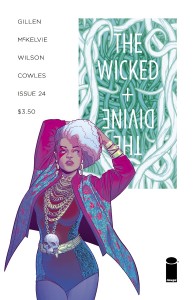 look a lot like this (and, here too, the cover image up there, this time to the left, will tell you whether you’d like the comic — but who could resist that lovingly-detailed swamp-monster? The Wicked and the Divine is back to linear storytelling (after the gossip-magazine artifact last issue), which means McKelvie art and Gillen (making the list for the third time this week) script, and that Young Avengers team offers the usual: great-looking people with powers interacting with each other, sometimes violently, as they party desperately and grope toward an uncertain future; it’s great. Island, the Brandon Graham/Emma Rios-edited art-comic anthology series, reaches its 13th issue; there’ s six pages at the front by Jack Cole (not the Plastic Man creator, but another, presumably younger, artist who does cool-looking Barry Windsor Smith-esque giant skeletons), 28 pages of Grim Wilkins’s Mirenda, about characters having adventures on a
look a lot like this (and, here too, the cover image up there, this time to the left, will tell you whether you’d like the comic — but who could resist that lovingly-detailed swamp-monster? The Wicked and the Divine is back to linear storytelling (after the gossip-magazine artifact last issue), which means McKelvie art and Gillen (making the list for the third time this week) script, and that Young Avengers team offers the usual: great-looking people with powers interacting with each other, sometimes violently, as they party desperately and grope toward an uncertain future; it’s great. Island, the Brandon Graham/Emma Rios-edited art-comic anthology series, reaches its 13th issue; there’ s six pages at the front by Jack Cole (not the Plastic Man creator, but another, presumably younger, artist who does cool-looking Barry Windsor Smith-esque giant skeletons), 28 pages of Grim Wilkins’s Mirenda, about characters having adventures on a 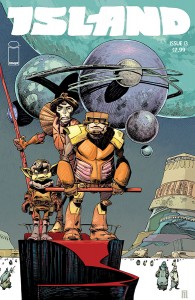 world of magic, some wandering through a forest and some on a mountain peak; they speak in pictographs, and I have no idea what’s going on, but it sure looks pretty. There’s five pages of Fil Barlow’s Yippo, which takes place in a Yellow Submarine-ish fantasy world, and 20 pages of Lando’s Island, which looks like something Moebius would have scribbled on the pad and paper on his nightstand after waking from a particularly vivid dream, concluding with a nine-page art-school tone poem by Cynthia Alfonso. There are at least a couple of stories to appeal to any reader’s taste there, which is how a comic this stubbornly unique has lasted as long as it has.
world of magic, some wandering through a forest and some on a mountain peak; they speak in pictographs, and I have no idea what’s going on, but it sure looks pretty. There’s five pages of Fil Barlow’s Yippo, which takes place in a Yellow Submarine-ish fantasy world, and 20 pages of Lando’s Island, which looks like something Moebius would have scribbled on the pad and paper on his nightstand after waking from a particularly vivid dream, concluding with a nine-page art-school tone poem by Cynthia Alfonso. There are at least a couple of stories to appeal to any reader’s taste there, which is how a comic this stubbornly unique has lasted as long as it has.



